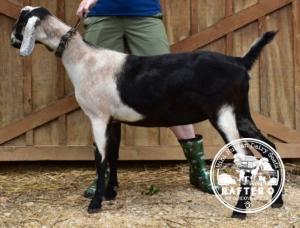
When I first was interested in obtaining dairy goats, I started researching all of the different breeds. I was really drawn to the Nubian breed…those long ears, roman noses, and friendly personalities. Upon learning about the large size of the standard breeds, I was ecstatic when I came across Miniature Dairy goats – a cross between the standard-sized breed and a Nigerian Dwarf. This would be ideal for my small acreage, and they would be easier to handle for milking, grooming, and showing. I settled on the Miniature Nubian, and began looking for a few goats to join my farm.
Upon researching more about the Mini Nubians, I learned that there are generations…all the Fs you see. The cross of a standard Nubian to a Nigerian Dwarf results in a first generation or F1. Subsequent breedings result in kids that are one generation higher than the lowest parent. For example, if you breed an F1 to an F1 you have F2 kids. If you breed an F1 to an F6, you still have F2 kids (one generation higher than the lowest parent). An F6 to an F6 would be F7. First and second generation are considered are entered into the “Experimental” herdbook with MDGA. Third through fifth generations that meet the breed standards and the 70/30 rule are registered as “American.” Sixth generation, and beyond, are considered “Purebred” if they meet the breed standard.

At the time when I was first getting into goats, my thought was that if F6 is “Purebred” then those are the BEST goats, and I should try to purchase only “Purebred”. Our first goats were a 6th gen doe, Eddy Place Kandi Kisses, and a 5th gen doe with her 5th gen doeling, Goat Trails Pixie. While these were nice goats, my goat experience over the years has taught me to not focus so much on the generation! While the ultimate goal of breeding Mini Nubians is to eventually get to “Purebred” goats, us breeders must make sure we are not sacrificing quality to just breed up to get to higher generations. The MDGA Breed Standards for Mini Nubians requires that animals have roman noses, pendulous ears, and be no taller than 29 inches for does and 31 inches for bucks.
My message here is don’t get stuck on a number. Do not assume that a 6th generation is better than a 3rd generation. Do not assume that an 8th generation is better than a 6th generation. These generation numbers don’t matter as much as the quality of the animal’s pedigree, milk lines, disease testing, temperment, and so on. As I’ve learned more about the Mini Nubians, I tend to look at the percentages more than generation. For example, I wanted to infuse some great Nubian genetics into my herd. When I found Nomad Once in a Blue Moon “Clair”, I knew I had to have her!

She was the rare color pattern, Cou Clair, and she has a stellar pedigree with champions and milk for generations. Clair is an F1 Mini Nubian with 96.88% Nubian and 3.12% Nigerian. I hear folks comment that she has great ears for an F1. These folks are thinking that she is a 50/50 F1. Her sire is standard Nubian and dam is F1 with high percentage Nubian – so you can see she is about 97% Nubian, so her breed character should be phenomenal, and it is. So, don’t get stuck on that generation number. Look a little deeper at these animals to ascertain their quality.

The Rafter O herd has almost every generation from 0 (standard Nubian) to 7th gen. Most of our higher generations are 50-60% Nubian – 40-50% Nigerian. Our 1st and 2nd generation Rafter O kids are about 77% Nubian. Again, my point is don’t get stuck on that generation number.
So, whether you’re just starting out with Mini Nubians or you’re looking to grow and refine your herd, my advice is simple: look deeper than the generation number. It’s easy to get caught up in chasing “Purebred” status or aiming for that next generation milestone, but don’t let that overshadow what really matters. A high-generation goat doesn’t automatically mean it’s a better animal. Instead, take the time to evaluate each goat on an individual basis.
Look at the percentage of Nubian to Nigerian genetics—this can tell you a lot about what traits the goat might express. Examine the pedigree for proven lines, especially those known for strong milk production, long lactations, or excellent udder structure. Ask for udder photos—you want to see well-attached, productive udders, even on younger does. Check for milk stars and performance records, which are great indicators of a goat’s value as a dairy animal. Look into health testing and biosecurity practices—a healthy herd is the foundation of good breeding. And finally, don’t underestimate the importance of temperament and personality. A friendly, easy-to-handle goat is worth its weight in gold when it comes to daily chores, milking, and showing.
In the end, it’s not about how many generations your goat has behind it—it’s about the quality that comes from thoughtful, responsible breeding. Whether a goat is F1 or F8, what really counts is how well it represents the Mini Nubian breed, both in form and function. So next time you’re evaluating a potential herd addition, go beyond the generation. Look at the full picture. That’s where you’ll find the true value.




